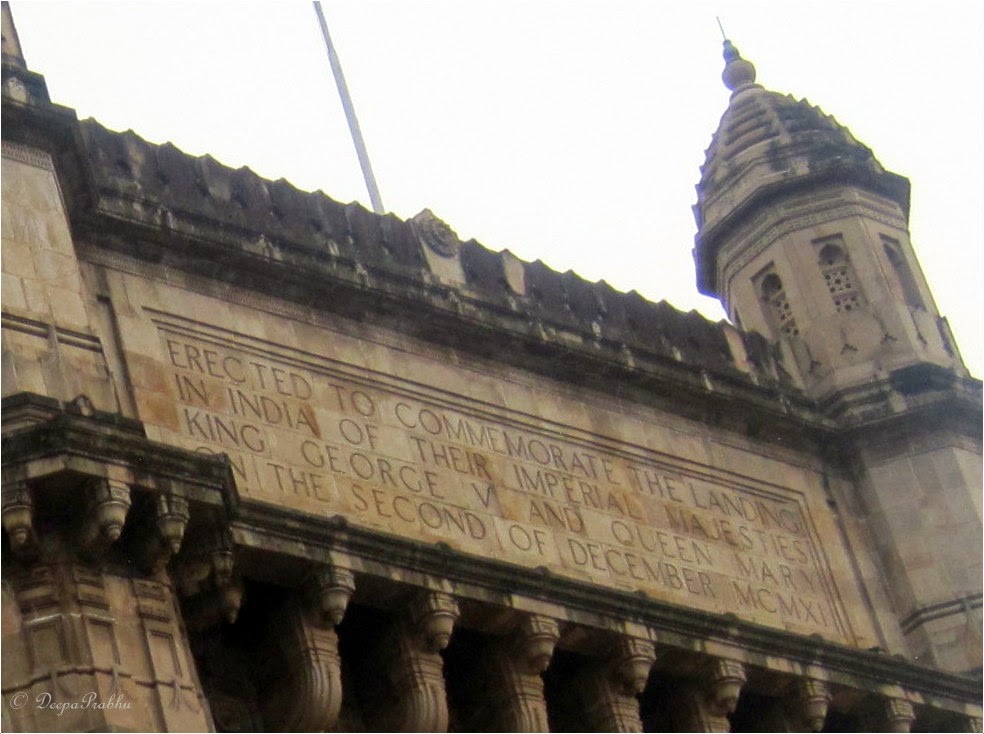The Gateway of India is a monument built during the British Raj in Mumbai (formerly Bombay), India. It is located on the waterfront in the Apollo Bunder area in South Mumbai and overlooks the Arabian Sea. The structure is a basalt arch, 26 metres (85 feet) high. It lies at the end of Chhatrapati Shivaji Marg at the water's edge in Mumbai Harbour. It was a crude jetty used by the fishing community which was later renovated and used as a landing place for British governors and other prominent people. In earlier times, it would have been the first structure that visitors arriving by boat in Mumbai would have seen. The Gateway has also been referred to as theTaj Mahal of Mumbai, and is the city's top tourist attraction. (Source of Information)
The writings on the Gateway of India which reads "Erected to commemorate the landing in India of their Imperial Majesties King George V and Queen Mary on the Second of December MCMXI"
The Gateway of India was built to commemorate the visit of King George V and Queen Mary to Mumbai, prior to the Delhi Durbar, in December 1911. However, they only got to see a cardboard model of the structure since the construction did not begin till 1915. The foundation stone was laid on 31 March 1911, by the governor of Bombay Sir George Sydenham Clarke, with the final design of George Wittet sanctioned on 31 March 1913. The gateway was built from yellow basalt and concrete. Between 1915 and 1919, work proceeded at Apollo Bundar (Port) to reclaim the land on which the gateway and the new sea wall would be built. The foundations were completed in 1920, and construction was finished in 1924.The gateway was opened on 4 December 1924, by the viceroy, the Earl of Reading.
The last British troops to leave India following the country's independence, the First Battalion of the Somerset Light Infantry, passed through the gateway on their way out in a ceremony on 28 February 1948, signalling the end of British rule
Design And Architecture - The architect George Wittet combined the elements of the Roman triumphal arch and the 16th-century architecture of Gujarat. Its design is a combination of Hindu and Muslim architectural styles; the arch is of Muslim style while the decorations are of Hindu style.The gateway is built from yellow basalt and reinforced concrete. The stone was locally obtained, and the perforated screens were brought from Gwalior. The gateway faces out to Mumbai Harbour from the tip of Apollo Bunder.The central dome is 48 feet (15 metres) in diameter and 83 feet (25 metres) above the ground at its highest point. The whole harbour front was realigned in order to come in line with a planned esplanade which would sweep down to the centre of the town. On each side of the arch, there are large halls that can hold 600 people. The cost of the construction was  2 million (US$32,000), borne mainly by the Government of India. For lack of funds, the approach road was never built, and so the gateway stands at an angle to the road leading up to it.
2 million (US$32,000), borne mainly by the Government of India. For lack of funds, the approach road was never built, and so the gateway stands at an angle to the road leading up to it.
View of Gateway of India and Taj Hotel from sea - (captured it long back in year 2009, Please forgive me for image clarity since it was captured using mobile phone camera)
It is the place where the viceroys and governors used to land upon their arrival in India. Though built as a welcome to King George V for his visit of 1911, then an event of grand significance for British India and the British empire, today serves as a "monumental memento" of colonialisation and subjugation by the British over the people of India. Built right next to the Taj Mahal Palace & Tower hotel, for British arriving for the first time to India, the gateway was a symbol of the "power and majesty" of the British empire.
Opposite the gateway stands the statue of Chhatrapati Shivaji Maharaj. The statue was unveiled on 26 January 1961 on the occasion of India's Republic Day. The other statue in the area is that of Swami Vivekananda.There are five jetties at the gateway.The first jetty is exclusive to the Atomic Research Centre, the second and third are used for commercial ferry operations, the fourth is closed and the fifth is exclusive to the Royal Bombay Yacht Club.
This post is a part of Thursday Challenge. Thursday Challenge is a place for photographic fun and learning. Theme is announced on this site every week. Theme for this week is " ARCHITECTURE " (Buildings inside and out of all kinds) Link to Thursday challege







Icon of Mumbai
ReplyDeleteWow, Lovely photos.....:)
ReplyDeleteThis place is majestic.
ReplyDeleteThe Taj Mahal of Mumbai has interesting architecture. An insight to one beautiful architecture.
ReplyDeleteHari OM
ReplyDeleteBeautiful and well done on providing the info... you got one catpure I never managed, as I never got the chance to go out on the water; so mobile phone or not, that's my favourite shot!!! YAM xx
I visited here, of course, when I first began my "long" India stays in Dec 2011. Since then, I have spent a total of a year and a half in India, my favorite time was five months in Jaipur. I return to California Dec 3 after five months in Mumbai. I should have visited the Gateway of India again. My pictures were taken only at night so it was wonderful to see these daytime shots.
ReplyDeletesuch a congregation of people in the first shot - very interesting history
ReplyDeleteThat is very beautiful architecture indeed!
ReplyDeleteA great effort with useful information!
ReplyDeleteThe architecture of this building is lovely though its purpose is sad.
ReplyDeleteWonderfull gate much work architectural, Greeting from Belgium
ReplyDelete